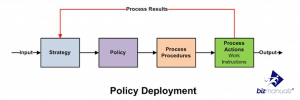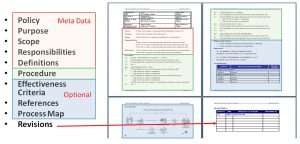Does Every Policy Need a Procedure?

Policy and procedure, together, make up the realm of governance and management. Policies are the outline and guidelines for decisions and actions, but they need procedures to actually be effective. Procedures are the steps to follow a policy’s aims. Does every policy need a procedure?
The MECE Principle and its Importance in Policy Development

Business Policy Deployment includes your strategy, policies, procedures, and work instructions.
To ensure your policies are effective and well-structured, utilize the MECE Principle. Define and explain the MECE Principle to establish clarity. Discover the benefits of incorporating the MECE Principle in policy development for streamlined processes and comprehensive outcomes.
To illustrate this, let’s look at NASA’s space shuttle program. The Challenger disaster happened because of flawed decision-making and communication. After that, stricter policies were put in place. But, these weren’t enough. Procedures that emphasized testing and communication among teams were also needed.
These policies and procedures were a must for successful launches. They created public trust and allowed goals to be achieved safely. The combination of the two was essential.
Definition and Explanation of the MECE Principle
The MECE Principle stands for Mutually Exclusive and Collectively Exhaustive. It’s a concept used in policy development to make sure everything is covered without any overlap. This Principle helps split up complex problems into manageable chunks, so that they can be analyzed systematically. All possible options and alternatives are addressed, so nothing vital is forgotten.
Let’s use and example: a government making policies to tackle unemployment. They’d break it into different, mutually exclusive categories. For example: education, training, job creation, and support services. Everything within each category would be explored exhaustively. This comprehensive approach allows them to look at the issue from various angles, without duplicating efforts.
The MECE Principle also helps develop effective strategies. Decision-makers can evaluate each alternative separately before looking at their collective impact. This methodical analysis reduces the risk of missing potential solutions or falling for cognitive biases.
It doesn’t stop there. The MECE Principle also makes communication easier. When presenting ideas or recommendations based on this Principle, policymakers can explain their proposals logically and concisely. This way, stakeholders are more likely to understand and support them.
Benefits of using the MECE Principle in Policy Development
MECE is a great tool for policy development. Its advantages include clarity, completeness, and structure. It breaks down complex issues into mutually exclusive categories while leaving no option unthought of.
Logical thinking and no overlap or redundancy make MECE solutions better. It also ensures better communication between stakeholders by presenting the information clearly. It helps find gaps in existing policies and develop new ones.
Efficiency and accountability come from using MECE, as resources can be allocated effectively with desired outcomes. It’s a must-have for successful policy implementation and positive impact on communities. Don’t miss out on its potential; it’s the key to effective policy development.
The marriage of policies and procedures is clear – policies are the grand ideas while procedures are the details that make them work.
The Relationship between Policies and Procedures
To understand the relationship between policies and procedures, delve into the difference between policies and procedures and discover how they complement each other. Gain insights into the benefits of having policies and procedures in place and their crucial roles in establishing effective organizational frameworks.
Understanding the difference between policies and procedures
Policies and procedures are two required parts of any company, each with its own different aim. Policies explain the rules and beliefs that guide decision-making and create a plan for equal actions. Procedures, however, provide step-by-step instructions on how to do jobs or operations within and organization. Knowing the difference between these two is vital for keeping order and efficacy.
For more information on the contrast between policies and procedures, let’s consider their characteristics:
| Policies | Procedures |
|---|---|
| Broad laws | Exact orders |
| High-level objectives | Detailed steps |
| Relevant to different scenarios | Designed for certain tasks |
| Long-term focus | Immediate implementation |
Policies set the overall goals and objectives of and organization, providing a general plan for decision-making. They give staff a structure for making decisions that agree with organizational values. Procedures, on the other hand, go into the exact steps necessary to accomplish those objectives. They give precise directions for doing tasks in a consistent way.
It is essential to remember that policies control procedures. Without proper policies in place, it is hard to make useful procedures that support corporate goals. Policies set the limits in which procedures work, making sure consistency among employees’ activities.
According to Harvard Business Review, companies with clear policies and procedures have higher levels of worker pleasure and productivity. Why policies and procedures fit together: They are like a mismatched couple, always arguing but ultimately keeping each other in check.
Why Policies and Procedures Complement each other
Policies and procedures go together like two dancers in a harmonious performance. Policies provide the overarching guidelines and principles that govern and organization. Procedures outline the exact steps and actions to be taken to implement those policies. This creates a framework for consistency, transparency, and accountability.
Policies establish the rules and expectations for employee behavior. Without policies, confusion and chaos may arise from individuals interpreting situations differently or acting without guidance. Policies enable employees to make informed decisions that fit with organizational goals.
Procedures take policies a step further. They provide instructions on how tasks should be done, who is responsible, and what resources are needed. This ensures consistency and efficiency.
Policies and procedures also work together to mitigate risks. Policies identify potential hazards and set preventive measures. Procedures then provide the actions to take to address these risks. This helps protect assets and ensure compliance with regulations.
Organizations should consider a few tips to maximize the effectiveness of policies and procedures:
- Regular review: Change is constant. Reviewing policies and procedures often helps identify gaps or outdated practices that could be hindering efficiency or introducing risk.
- Clear communication: All employees should understand the content and implications of policies and procedures. Make them accessible and understandable.
- Training and support: Adequate training is essential to successful implementation. Invest in resources and tools to help employees follow the guidelines.
- Continuous improvement: Encourage feedback from employees and stakeholders. This allows for refining policies and procedures and improving the organizational framework.
Timing is key when policies and procedures meet – just like adding eggs to a recipe so they don’t scramble.
When to include Procedures in Policies
To effectively determine when procedures should be included in policies, consider the solutions provided in the section “When to include procedures in policies” with the sub-sections “Identifying the need for a procedure” and “Examples of policies that require procedures.”
Identifying the need for a procedure
When deciding to put a procedure in a policy, many factors must be taken into account. Complexity of the task is and important one. If the task has multiple steps or difficult decisions, writing out a procedure is a good idea. This helps to make sure all steps are done in the right order.
Frequency of the task is also important. If it’s done often, having a standardized procedure makes things more efficient and helps to avoid mistakes. This is especially important if various departments or people are involved, as the procedure can help everyone stay consistent and work together.
Consequences of errors should also be considered. If the mistakes can have huge impacts, like legal or financial harms, it’s wise to include a clear procedure to reduce risk and keep expensive mistakes from happening.
To do this, organizations should:
- Outline the goal: Writing the exact aim of the procedure helps everyone stay on track and stay aligned with organizational objectives.
- Break down tasks: If there are many steps or decisions, break them into smaller sub-tasks and give clear instructions. This makes it easier for employees to follow and reduces confusion.
- Provide resources: Give documents, templates, and tools to help people complete the procedure correctly. This takes away ambiguity and encourages people to stick to the procedure.
By taking these steps when adding procedures to policies, organizations can make things smoother, reduce risks, and create and efficient and consistent culture. Knowing when to add a procedure is just the start – success relies on proper implementation of the policies and procedures.
Examples of policies that require procedures
Policies like Data Security, Employee Onboarding, Incident Management, and Quality Control all require procedures. Plus, there are policies like the Code of Conduct and Health and Safety Policy that have corresponding procedures. These assist with legal and ethical standards and keep workplaces safe.
Unfortunately, policies that don’t have clear procedures can lead to chaos and inconsistency. But, when procedures are well-defined, organizations can promote transparency, accountability, and efficiency.
Forbes reported that companies with comprehensive policies and procedures experience higher compliance rates and lower risks of legal violations. But, sometimes it feels like you’re playing hide and seek with procedures – you search for hours only to find out you never needed them in the first place.
When Procedures may not be Necessary
To effectively navigate the realm of policy-making, it is crucial to recognize situations where policies can stand alone and factors to consider before excluding procedures. This section delves into the intricacies of when procedures may not be necessary, providing insights into the importance of sound decision-making and policy implementation.
Situations where policies can stand alone
Situations can come up where policies work best all by themselves. These scenarios are characterised by clear guidelines and precise processes that leave no space for guesswork or personal interpretation. In such scenarios, the policy itself gives enough direction to ensure compliance and reach the sought-after result.
Here are some events where policies are suitable to stand alone:
- Routine tasks: When the job at hand is a straightforward and repetitive one, a policy should be enough to guide employees in doing it right.
- Established best practices: When there are already well-established best practices in a certain industry, a policy outlining those practices can serve as a good reference for employees to follow.
- Emergencies: During crises, fast decisions are critical. Having clear policies ready can help employees react quickly and effectively without requiring extra guidance from procedures.
- Basic admin tasks: Certain administrative tasks like filing documents, managing records, or upgrading databases often don’t need detailed steps. A simple policy can be enough to lead employees through these regular tasks.
It is important to remember that policies may not always be enough in complex or confusing situations that require more precise instructions. But in cases where clear rules exist and there is no room for personal opinion, policies can be left on their own.
As and example, and organization had to make their expense management process smoother. After evaluating it, they realised that creating and exact procedure for every expense type would be too time consuming and impractical because of the frequent changes in expense types. Thus, they made a comprehensive expense policy that had clear instructions on what expenses were repayable and under what conditions. This approach enabled them to simplify their processes while still keeping control over expenses.
By knowing when policies can work on their own and exploiting their advantages correctly, organisations can streamline operations without sacrificing productivity or compliance. Before omitting procedures, just ask yourself: is it going to cost me and arm and a leg, or is it more of a finger and a toe situation?
Factors to consider before excluding procedures
Prior to omitting particular procedures, it is essential to contemplate numerous factors. These deliberations can help decide if a procedure is actually unnecessary or holds value in certain cases. By assessing these factors attentively, healthcare professionals may make wise decisions that prioritize patient welfare and optimize resource allocation.
To aid this choice-making process, the following table presents key elements to consider before excluding procedures:
| Factor | Description |
|---|---|
| Patient Safety | Estimate the potential risks to the patient if the procedure is not performed. Assure that exclusion does not compromise patient safety. |
| Evidence-Based Practice | Appraise the existing research and clinical guidelines supporting or opposing the procedure’s implementation. Bear in mind any emerging evidence that may influence its necessity. |
| Cost-Effectiveness | Examine the financial implications of performing or excluding the procedure. Consider costs related to equipment, personnel, and potential long-term savings from excluding it. |
| Alternative Options | Investigate alternative interventions or approaches that may achieve similar outcomes, reducing reliance on a specific procedure without sacrificing efficacy. |
| Patient Preferences | Comprehend and respect individual patients’ values and preferences regarding the procedure, considering their autonomy in medical decision-making. |
| Healthcare Resources | Assess accessible resources such as staff availability and facility capacity when evaluating whether a particular procedure should be excluded due to limitations in resources. |
It is imperative to observe that each case is unique, and factors may act differently relying on exact circumstances. Therefore, healthcare providers must take into account these components holistically when deciding if a procedure merits exclusion.
In delving deeper, one crucial consideration is the ethical aspect associated with excluding procedures. Ethical predicaments may arise when balancing patient autonomy, beneficence, and justice within healthcare practice.
In history, there have been occurrences where procedures once thought to be indispensable were later established to be unnecessary or even harmful. For instance, tonsillectomies were regularly conducted to combat recurrent throat infections in the past. Nevertheless, advancements in medical knowledge exposed that the procedure was not always beneficial and could bring about complications. This historical viewpoint highlights the need for routinely reviewing procedures to guarantee they agree with current evidence and best practices.
By cautiously weighing these factors, healthcare professionals may make judicious decisions regarding the exclusion of certain procedures. Such decisions seek to optimize patient care, safety, and resource utilization while staying up-to-date with evolving medical knowledge and ethical considerations.
Best Practices for Developing Effective Policies and Procedures
To develop effective policies and procedures, start with clear steps to follow in policy and procedure development. Additionally, pay attention to key considerations for clarity and ease of implementation.
Steps to follow in policy and procedure development
Create successful policies and procedures with these steps. They are like a guide for organizations, giving them clear and complete guidelines that help with consistency and productivity.
- Find the need: Start by finding the exact problem or issue that needs a policy or procedure. This could be related to employees’ behaviour, safety rules, or any other operational factor that needs explanation.
- Do research: Gather all relevant information and talk to experts in the field to get a full understanding of the topic. This step helps to find what works best, legal requirements, and standards of the industry.
- Write the policy/procedure: Take the gathered info and make a detailed draft. Clearly state objectives, roles/responsibilities, results expected, and any steps or actions to be taken. It is key to be clear and avoid uncertainty.
- Get feedback and approval: Give the draft to key people, including bosses, legal advisors, and staff that may be affected by the policy or procedure. Ask for their input and include their advice for improvement.
- Communicate: When done, share the policy or procedure throughout the organization with emails, meetings, trainings, etc. Reinforce important points to make sure it is understood and followed.
- Monitor and review: Look at policies and procedures regularly to make sure they are up-to-date with changes in the law or the organization. Set up a system for feedback and right away fix any problems that come up.
Each organization requires different things when making policies and procedures. These steps give a general idea but may need to be adapted depending on the situation.
Pro Tip: Check policies and procedures every now and then to make sure they fit the ever-changing needs of the organization and external factors such as legal changes or industry trends. Constant evaluation helps make improvements over time.
Developing effective policies and procedures is difficult and essential – like doing taxes!
Key considerations for clarity and ease of implementation
Text: Key considerations for clarity and ease of implementation are super important when making effective policies and procedures. They make sure everyone understands and they can be implemented without any clashes or complications.
Here are the key considerations:
- Clear language: Use simple sentences and avoid technical lingo that could befuddle readers.
- Organization: Put the info in and easy-to-follow way. Break big processes into smaller parts.
- Consistency: Keep it consistent in format, structure, and words. This helps to avoid any misunderstandings.
- Visual aids: Add diagrams, flowcharts, or infographics to help out. These can simplify complex concepts and give people a visual guide.
- Training & comms: Make sure everyone knows what they’re doing. Set up communication channels to answer any questions.
These considerations are important to keep in mind when making policies and procedures. It’s important to strike a balance between giving enough details and avoiding too much info or repeating ideas. Clear language and consistency is a must – a company once had employees misunderstanding instructions due to lack of both, causing delays and costly errors. So it’s essential to use these considerations!
Policy Need a Procedure
Not every policy needs a procedure. Policies give direction but if the dangers or complexity is low, then no procedure is needed. Policies without a procedure can let organizations change quickly.
It’s important to analyze the policy when deciding if a procedure is needed. For example, a policy about money needs accurate and accountable procedures.
Sometimes policies are more open-ended and do not need specific procedures. This encourages individual judgement and discretion. For instance, a policy supporting creativity on a team likely does not need rigid procedures.
Organizations should find a balance between clarity and flexibility when deciding if a procedure is needed. By tailoring the detail of the procedures to the policy, organizations can apply the policy while staying agile.
Harvard Business Review suggests that too many procedures can slow productivity and creativity. Finding the right balance between policies and procedures is important to promote innovation and uphold standards.
Frequently Asked Questions

FAQ 1:
Q: Does every policy need a procedure?
A: Not every policy needs a separate procedure. While policies provide guidelines and principles, procedures offer step-by-step instructions on how to implement those policies. Only policies that require specific actions or processes need accompanying procedures.
FAQ 2:
Q: What is the purpose of having procedures?
A: Procedures are essential for ensuring consistent and efficient implementation of policies. They provide clear instructions, define responsibilities, and establish a framework for decision-making, thereby promoting organizational effectiveness and reducing ambiguity.
FAQ 3:
Q: Can policies exist without procedures?
A: Yes, policies can exist without specific procedures. However, without accompanying procedures, implementation may lack structure and consistency. Procedures enhance the practical application of policies, facilitating their effective execution within and organization.
FAQ 4:
Q: How are policies and procedures related?
A: Policies and procedures are interconnected but serve different purposes. Policies outline overarching principles and guidelines, while procedures provide detailed instructions for carrying out those policies. Procedures support the effective implementation of policies by providing a systematic approach.
FAQ 5:
Q: Is it necessary to document policies and procedures?
A: Yes, documenting policies and procedures is crucial for clarity and transparency within and organization. Written documentation ensures that everyone has access to the same information and can follow consistent processes. It also aids in training new employees and facilitates compliance with regulatory requirements.
FAQ 6:
Q: How often should policies and procedures be reviewed?
A: Policies and procedures should be periodically reviewed to ensure their relevance and effectiveness. Factors such as changes in regulations, organizational structure, or industry practices may necessitate updates. Regular reviews help maintain the alignment of policies and procedures with the evolving needs of the organization.
















Leave a Reply